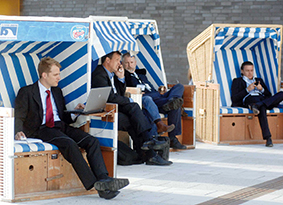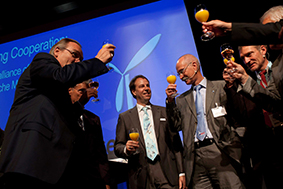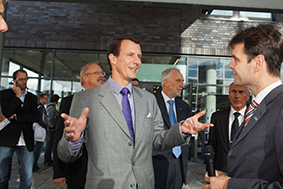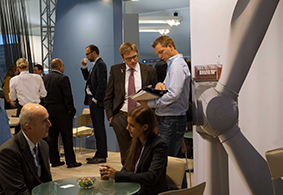 On Saturday 22 September 2012 HUSUM WindEnergy drew to a close. This year’s fair attracted a record number of visitors (almost 36,000). And the total of 1,171 exhibitors demonstrates a growth of 20% compared with the 2010 fair. This year, for the first time, Windtech International published the HUSUM Daily, which was very well received by both visitors and exhibitors. All the daily issues can be viewed online at www.windtech-international.com/husum-daily-2012. In this short review we try to give a brief summary of this year’s HUSUM for those who were not able to attend.
On Saturday 22 September 2012 HUSUM WindEnergy drew to a close. This year’s fair attracted a record number of visitors (almost 36,000). And the total of 1,171 exhibitors demonstrates a growth of 20% compared with the 2010 fair. This year, for the first time, Windtech International published the HUSUM Daily, which was very well received by both visitors and exhibitors. All the daily issues can be viewed online at www.windtech-international.com/husum-daily-2012. In this short review we try to give a brief summary of this year’s HUSUM for those who were not able to attend.
{access view=!registered}Only logged in users can view the full text of the article.{/access}{access view=registered}
Once again, the HUSUM fair was another huge event. Better still, the diversity of the products which were shown and demonstrated was very wide as well. The products displayed during the early fairs were very closely linked to the technology of the wind turbine itself, whereas the present palette of products covers a much wider range, including turbine components, manufacturing processes, operation and maintenance technology (which is very quickly developing as an area of expertise all of its own) and all sorts of finance and planning-related services. The topics discussed in various presentations and around the exhibition hall varied from potentially groundbreaking technologies to innovations in small components and techniques, which all allow cost reductions, both in the manufacturing of a wind turbine system and in its operation. This diversification – and associated specialisation – shows just how far the sector itself has developed over the last 23 years.Windalliance Technology Award
 The Windalliance Technology Award, an international technology prize presented jointly by Messe Hannover and Messe Husum, was awarded for the first time at HUSUM WindEnergy 2012. This year the award was won by SkyWind GmbH. New components for wind turbines are usually tested on the supplier’s test benches or at research establishments, which can only come close to real operating conditions. With the new development honoured by the award, SkyWind has created a modular test turbine in the multi-megawatt range with which manufacturers can test their products under real conditions. The wind turbine has a modular design, which enables the main components – such as gears, generators and main bearings – to be separately controlled, exchanged and tested during operation. This means it is possible to install components and very varied drive concepts from different manufacturers into the system without the need for cost-intensive customisation work. ‘SkyWind’s overall concept is at the same time unique, ambitious and revolutionary’, said juror Alois Schaffarczyk in his laudation. The jury was unanimous in its decision to award the prize to SkyWind.
The Windalliance Technology Award, an international technology prize presented jointly by Messe Hannover and Messe Husum, was awarded for the first time at HUSUM WindEnergy 2012. This year the award was won by SkyWind GmbH. New components for wind turbines are usually tested on the supplier’s test benches or at research establishments, which can only come close to real operating conditions. With the new development honoured by the award, SkyWind has created a modular test turbine in the multi-megawatt range with which manufacturers can test their products under real conditions. The wind turbine has a modular design, which enables the main components – such as gears, generators and main bearings – to be separately controlled, exchanged and tested during operation. This means it is possible to install components and very varied drive concepts from different manufacturers into the system without the need for cost-intensive customisation work. ‘SkyWind’s overall concept is at the same time unique, ambitious and revolutionary’, said juror Alois Schaffarczyk in his laudation. The jury was unanimous in its decision to award the prize to SkyWind.Royal Visit to the World Wind Capital
 On the second day of HUSUM WindEnergy, His Royal Highness Prince Joachim of Denmark honoured the trade fair with his presence. Before delivering the opening speech at the Windmasters Dinner at Husum Castle in the evening, the Prince, who is well known for his interest in conservation and renewable energy, visited Danish companies at the world’s biggest wind power exhibition. The son of Queen Margaret had come to Husum from the Danish town of Mögeltondern, and on an hour-long tour he learned all about the latest technological trends and developments in the wind power industry. He dropped in on selected exhibitors including Svendborg Brakes, Mita Technik, Vestas and the Danish national booth.
On the second day of HUSUM WindEnergy, His Royal Highness Prince Joachim of Denmark honoured the trade fair with his presence. Before delivering the opening speech at the Windmasters Dinner at Husum Castle in the evening, the Prince, who is well known for his interest in conservation and renewable energy, visited Danish companies at the world’s biggest wind power exhibition. The son of Queen Margaret had come to Husum from the Danish town of Mögeltondern, and on an hour-long tour he learned all about the latest technological trends and developments in the wind power industry. He dropped in on selected exhibitors including Svendborg Brakes, Mita Technik, Vestas and the Danish national booth.Future of Wind Power
As part of the HUSUM WindEnergy exhibition, Messe Husum organised a chaired round of discussions on the future of wind power. Politicians, power suppliers and manufacturers from Germany, Denmark and China discussed some of the industry’s most important topics. Heading the talks was Professor Dr Jochen Twele, wind power expert and lecturer at HTW Berlin University of Applied Sciences. Some of the thoughts put forward by the panel members are summarised in the following paragraphs.
Excess Wind Power for Heating
The Danish government intends to double wind power’s share in national production by 2020 so that it accounts for 50%. ‘We want excess wind energy to be used in cost-efficient electric boilers,’ said wind pioneer Preben Maegaard, Director of the Nordic Folkecenter for Renewable Energies, during the discussions. This would allow wind power to be sold at at least the same price as the fuel saved. ‘Until now, producers have had to sell off their excess wind power to the Energy Exchange at bad prices, or switch off their turbines. Because around 105 terawatt hours of power are needed for heating in Denmark each year, district heating represents a considerable market for the absorption of renewable energy peaks,’ added Maegaard.
Halting the Euro Crisis With Wind Power
Hans-Josef Fell, Member of the German Bundestag and Energy Spokesman for Bündnis 90/Die Grünen, sees things similarly. ‘The euro crisis is an oil crisis. Oil, gas and coal imports to the eurozone are more expensive than the expansion of renewable energies, and the cost of fossil fuel is rising.’ He also commented that wind power is the main driver behind renewables in Germany. ‘The euro crisis shows that it is much more expensive to stop the transformation of the energy sector. But if we keep that transformation going we will be able to supply Germany fully with renewable energies within only 15 years.’
Creating 40,000 Kilometres of New High Voltage Lines
The Chinese power grid was straining at the seams in 2011 because of the tremendous expansion of wind power. At 62.4GW of installed power, China is the world’s biggest wind market, and it also grew its production capacity more than any other country last year by adding 17.6GW to its tally. ‘To keep the wind market growing, the Chinese government is pushing forward the expansion of high voltage lines,’ explained Wu Gang, Chairman, Managing Director and President of Chinese company Goldwind. ‘The current five-year plan envisages the completion of 40,000 kilometres of new HV lines by 2015.’
Gaining Acceptance for Wind Power Through Industrialisation
Mike Winkel, Managing Director of E.ON Climate & Renewables, believes that the wind industry faces several challenges. ‘Wind turbines are still mainly isolated engineering achievements. We are working with manufacturers to standardise and industrialise the processes involved, from planning, to production, to the building of plants. Industrialising these things enables us to produce in larger quantities and reduce the cost of building and operation. This is central to the success of energy policy transformation: only if costs continue to fall will we be able to keep burdens down for consumers and secure acceptance for the continued expansion of wind power.’
From the Exhibition Floor
 The 2012 HUSUM exhibition showcased an almost uncountable number of items. The entire supply chain was represented, not only by the 'nuts and bolts' of hardware components but also by the huge variety of service products now needed by the industry. Both the supply side of the wind energy sector and the demand side – the customers of equipment and services – were to be found. Services offered at the fair included those needed for project design (design, R&D, grid connection, certification), project development (permitting, financing, business development, logistics, resource assessment, planning, selection and purchase of equipment, insurance, media), construction (logistics, transport, installation, grid connection) and operation and maintenance (R&D, inspection, logistics, repairs, component replacement, monitoring, green electricity supply/trading).
The 2012 HUSUM exhibition showcased an almost uncountable number of items. The entire supply chain was represented, not only by the 'nuts and bolts' of hardware components but also by the huge variety of service products now needed by the industry. Both the supply side of the wind energy sector and the demand side – the customers of equipment and services – were to be found. Services offered at the fair included those needed for project design (design, R&D, grid connection, certification), project development (permitting, financing, business development, logistics, resource assessment, planning, selection and purchase of equipment, insurance, media), construction (logistics, transport, installation, grid connection) and operation and maintenance (R&D, inspection, logistics, repairs, component replacement, monitoring, green electricity supply/trading).The huge offer of products and services at a fair such as HUSUM make it impossible to provide a fully comprehensive overview of the show. I suggest you visit the show yourself in 2014, and to get a feel for some of the new products and services introduced this year I encourage you to download the digital edition of the HUSUM Daily at www.windtech-international.com/husum-daily-2012.
HUSUM Wind 2014
After this year the fair is reverting to its old brand name of ’HUSUM Wind‘. In 2014 the fair will be organised from 23 till 26 September. And, once again, the team of Windtech International will be publishing the official HUSUM Daily 2014. See you then!{/access}










